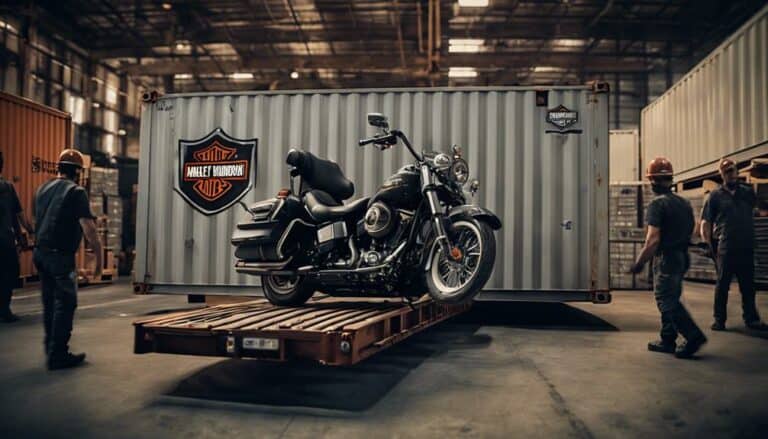So, Harley Davidson finds itself at a crossroads, pondering the intricate dance of global trade policies and their impact on the venerable motorcycle brand.
The decision to move production is not merely a whimsical shift; rather, it is a strategic response to the pressing need for cost efficiency in the face of mounting tariffs.
But what exactly does this move signify for the future of Harley Davidson and the broader narrative of international trade relations?
Key Takeaways
- To mitigate the impact of EU tariffs on motorcycles and maintain competitiveness in the European market.
- To achieve cost savings of around $100 million annually by leveraging overseas production facilities.
- To expand global presence, tap into new markets, and navigate global trade tensions effectively.
- To proactively address trade war risks and ensure sustainability amidst challenging trade dynamics.
Impact of Tariffs on Harley-Davidson
The imposition of a 31% tariff by the European Union on U.S. motorcycles has prompted Harley-Davidson to weigh the decision of relocating its production facilities. With each bike shipped to the EU incurring an additional $2,200 due to the tariffs, the company is considering shifting production overseas to avoid the impact of these EU tariffs on its business.
In 2017, Harley-Davidson sold over 40,000 motorcycles in Europe, making it a significant market for the brand. The Trump administration's tariffs on imported steel and aluminum resulted in retaliatory measures from the EU, further pressuring Harley-Davidson to contemplate moving production.
This move isn't just about economics but also about the strategic positioning of the company in response to changing trade dynamics. By considering this shift, Harley-Davidson aims to navigate the challenges posed by the EU tariffs while ensuring its continued presence and competitiveness in the European market.
Cost Savings From Overseas Production
Opt for relocating production overseas to achieve substantial cost savings due to EU tariffs. By moving production abroad, Harley-Davidson can save an estimated $100 million annually in taxes related to EU tariffs. Shifting manufacturing to international facilities enables the company to circumvent the extra $2,200 per motorcycle cost when exported to the EU. Harley-Davidson plans to leverage its factories in countries such as Brazil, India, and Australia to benefit from more favorable tariff positions. This strategic move not only helps the company stay competitive in the European market but also allows it to absorb short-term tariff expenses. Overseas production offers both cost-saving advantages and strategic benefits, offsetting the financial impact of EU tariffs on Harley-Davidson's operations.
| Benefit | Description | Impact |
|---|---|---|
| Cost Savings | Estimated $100 million annual savings due to EU tariffs | Significant financial advantage |
| Competitive Advantage | Ability to maintain competitiveness in the European market | Ensures market relevance and sustainability |
| Strategic Positioning | Utilizing factories in Brazil, India, and Australia for better tariff positions | Enhances flexibility and adaptability to trade regulations |
Global Market Expansion Strategy
Shifting production overseas allows Harley-Davidson to strategically expand its presence in the global market while mitigating the impact of EU tariffs on its operations. By moving some production outside the U.S., particularly to countries within the European Union, Harley-Davidson can maintain competitiveness in the European market. This move not only helps the company navigate global trade tensions but also presents a sustainable option for its international production.
With the threat of EU tariffs on American motorcycles, the decision to shift production overseas for EU sales becomes crucial in controlling prices for European consumers while upholding its American manufacturing reputation. Harley-Davidson's global market expansion strategy aims to offset declining sales in the U.S. by tapping into new markets abroad. This strategic approach aligns with the company's objectives to ensure long-term growth and stability in the face of evolving global trade dynamics.
Mitigating Trade War Risks
By relocating its production overseas, Harley-Davidson strategically mitigates the risks posed by trade wars, ensuring its competitiveness in the global market. Moving production to international facilities offers a sustainable option to alleviate the lasting detrimental impact of tariffs.
This strategic decision not only helps in reducing the tariff burden but also reflects a customer-centric approach by avoiding passing on the additional costs to customers in the EU. Shifting production locations is a proactive measure taken by Harley-Davidson to navigate the challenges of trade wars and maintain its position in the European market.
This move signifies the company's commitment to adapting to changing market conditions while prioritizing the interests of its customers and long-term sustainability. By embracing international production, Harley-Davidson aims to alleviate the E.U. tariff pressures, securing its foothold in the global motorcycle industry.
Maintaining Competitive Advantage
To maintain its competitive edge in the European market, Harley-Davidson strategically relocates production overseas to circumvent high EU tariffs. By shifting production overseas, the company anticipates saving $100 million per year, essential to maintain a viable business amidst trade challenges.
Controlling prices for global consumers becomes achievable through this strategic move, enabling Harley-Davidson to stay competitive in international markets. Moreover, by offsetting the impact of EU tariffs through production relocation, the company ensures it can sustain its business in Europe and retain its competitiveness.
This proactive approach not only safeguards Harley-Davidson's position in the European market but also demonstrates its commitment to adapting to changing trade dynamics to secure its future growth. In essence, the decision to shift production overseas is a strategic maneuver aimed at ensuring the company's long-term success and competitiveness in the global motorcycle industry.
Conclusion
In conclusion, Harley Davidson's decision to move production overseas is driven by the significant impact of EU tariffs on U.S. motorcycles. By shifting production to international facilities, the company aims to avoid additional costs and remain competitive in global markets.
This strategic move reflects the challenges posed by current trade dynamics and the need for companies to adapt to changing circumstances to thrive in the international arena.

